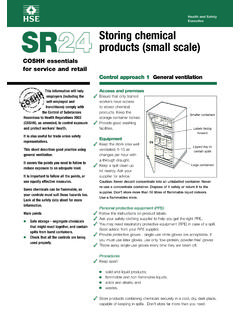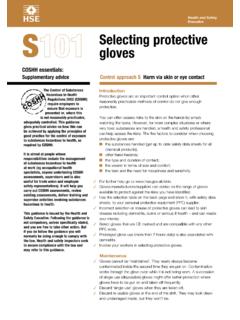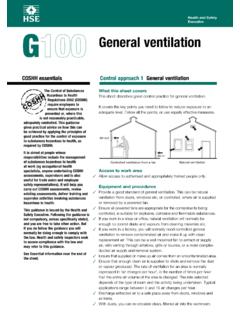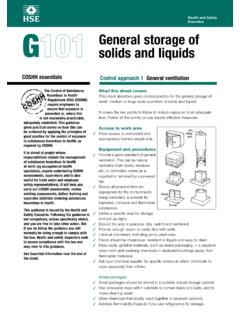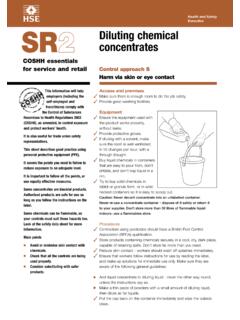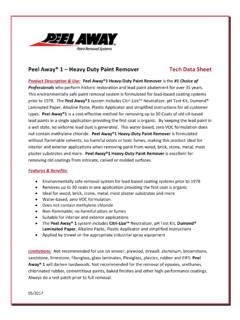Transcription of Bandsaws 2 - COSHH e-tool
1 2 BandsawsWoodwork control guidance sheet WD01 Engineering controlControl approach 2 WWDD01 This guidance sheet is foremployersto help themcomply with the requirements ofthe Control of Substances Hazardousto Health Regulations 2002 ( COSHH ) bycontrolling exposure to chemicals andprotecting workers sheet is part of HSE guidanceCOSHH essentials: easy steps to controlchemicals. It describes the key pointsyou need to follow to help reduceexposure to an adequate level. It isimportant to follow allthe points, or useequally effective dust can cause serious respiratorydiseases including asthma, anddermatitis. Wood dust includes dust fromhardwood, softwood, and compositeboards such as to substances which causeoccupational asthma should beprevented, or if that is not reasonablypracticable, control exposure to preventworkers from developing asthma.
2 Thisapplies to short-term high as well aslong-term exposures. If an individualdevelops occupational asthma, exposuremust be controlled to prevent triggeringfurther attacks. Suitable levels are likelyto be well below any exposure approach 2 (engineering control)is recommended to control dust frommechanical need also to control exposure to dust is combustible - build-up onledges etc can result in dust helps to reduce this environmental advice see Furtherinformation on the back Restrict access to those staff who need to be and equipment The cutting action creates coarse and fine dust, and pulleys act like fans toblow dust into the workroom. Fit extraction to control dust. Enclose the saw casing as much as possible to contain dust and reduce theamount of extraction needed. Additional extraction can be fitted at the openings in the blade casing, ifnecessary.
3 You need an air speed between 10 and 20 metres per second into the table slot. Ensure a manometer or pressure gauge is fitted near the extraction point, toshow that the extraction is working properly. Always confirm that the extraction is turned on and working at the start ofwork. Check the gauge. Keep extraction ducts short and simple - avoid long sections of flexible duct, it is easily damaged. Have a supply of clean air coming into the workroom to replace extracted can recirculate filtered air to the workroom. Keep the slot free of chippings to allow effective dust capture, and keep thelength of exposed saw blade as short as possible. Consult a qualified ventilation engineer to design new control systems (seeControl guidance sheet FD14).Maintenance Follow instructions in maintenance manuals. Keep equipment in effective and efficient working order.
4 Repair faulty extraction systems immediately. Meanwhile, wear respiratoryprotective equipment (RPE). Don t alter, add or remove extraction without specialist advice. Don t adjust thedampers yourself unless your extraction system is designed for and testing Look daily for signs of damage to the ducting, fan and air filter. Noisy orvibrating fans can indicate a problem. Repair damage immediately. At least once a week, check that the extraction system and gauge workproperly, with no dust leaks. You need to know the manufacturer s performance specification to know ifextraction is working properly. If this information isn t available, hire a competent ventilation engineer todetermine its performance. The engineer s report must show the target air speeds. Keep this information in your testing logbook. Get a competent ventilation engineer to examine the system thoroughly and testits performance at least once every 14 months (see HSE publication HSG54).
5 Keep records of all examinations and tests for at least five years. Review records to see if there are failure patterns that make planningmaintenance air monitoring to make sure the controls are working and housekeeping Clean the machinery and work area every day. Regular cleaning will help youfind dust leaks. Clean general workrooms once a week. Remember to clean overhead beams,heating pipes and light fittings to reduce the risk of secondary dust explosion. Use a Type H vacuum cleaner fitted with a HEPA filter to clear up dust. Don t clean up with a brush or with compressed air. Shovel large spills carefully to avoid stirring up dust. Dispose of wood dust waste by incineration or in a control guidance sheet WD01 ExtractionExtractionExtractionExtraction 10-20 m/sm/s = metres per secondPersonal protective equipment (PPE) Respiratory protective equipment (RPE) should not be needed if the extractionis designed correctly and working properly.
6 RPE is needed for maintenance and cleaning overhead. Use a P2 or P3 standard of RPE. Consult your supplier for advice. Replace RPE filters as recommended by your supplier. Throw away disposablemasks after one use. Keep RPE clean and store it away from dust. Skin creams are important for skin protection and help in washingcontamination from the skin. These are not barrier creams . After work creamshelp to replace skin oils. Never allow compressed air use for removing dust from surveillance Use health surveillance (see Control guidance sheet 402). There is a chance ofasthma developing, even with good controls in place. Use skin surveillance. Consult an occupational health professional (see Further information).Training Tell your workers that wood dust can cause asthma, cancer and dermatitis. Tellthem what the early signs of asthma are.
7 Provide health and safety training. Include supervisors and managers. Ask yourlocal Learning Skills Council for advice on training providers. Ensure training includes how to keep exposures low; how to check that theextraction is working ; how to use and look after PPE and RPE; and what to doif something goes Check that the extraction is working properly; PPE is being used properly; andthe rules on personal hygiene are being followed. Ensure the health surveillance programme is being carried out for everyonethat needs it. Ask your workers to check their skin for dryness or soreness every six these effects appear, check the proper use of skin creams and control guidance sheet WD01 Further information Maintenance, examination and testing of local exhaust ventilationHSG54(Second edition) HSE Books 1998 ISBN 0 7176 1485 9 An introduction to local exhaust ventilationHSG37 (Second edition) HSE Books 1993 ISBN 0 7176 1001 2 The selection, use and maintenance of respiratory protective equipment: Apractical guideHSG53 (Second edition) HSE Books 1998 ISBN 0 7176 1537 5 Safe use of woodworking machinery.
8 Provision and Use of Work EquipmentRegulations 1998 as applied to woodworking machinery. Approved Code ofPractice and guidanceL114 HSE Books 1998 ISBN 0 7176 1630 4 Toxic woodsWoodworking Information Sheet WIS30 HSE Books 1995 (also available via ) Controlling airborne contaminants in the workplaceTechnical Guide TG7 British Occupational Hygiene Society 1987 ISBN 0 9059 2742 7 Health and safety consultants: the BOHS Faculty of Occupational Hygienekeeps lists of qualified hygienists who can help you. Contact BOHS on 0133 229 8087 or at Occupational health professionals: details of doctors and nurses can be foundin the Yellow Pages under Health and safety consultants and Healthauthorities and services . Also visit the NHS website at on the scale of work, releases into the atmosphere may beregulated within the pollution prevention and control (PPC) framework.
9 Youshould consult your local authority or the Environment Agency. In Scotland,consult the Scottish Environment Protection Agency (SEPA). They will adviseyou if PPC legislation applies to your company, and about air cleaning anddischarging emissions into the air. Otherwise, minimise emissions into the checklistAlways follow the standardoperating the extraction switchedon and working properly, withthe guard properly adjusted?Check the for signs of leaks,wear and you find any problems,tell your supervisor. Don t justcarry on with healthsurveillance , maintain and storeyour PPE in accordance up sawdust your hands beforeand after eating, drinking,smoking and using the use solvents to cleanyour skin creams providedas control guidance sheet WD01 COSHH essentials:easy steps to control chemicalsOctober 2003 Printed and published by the Health and Safety Executiv
